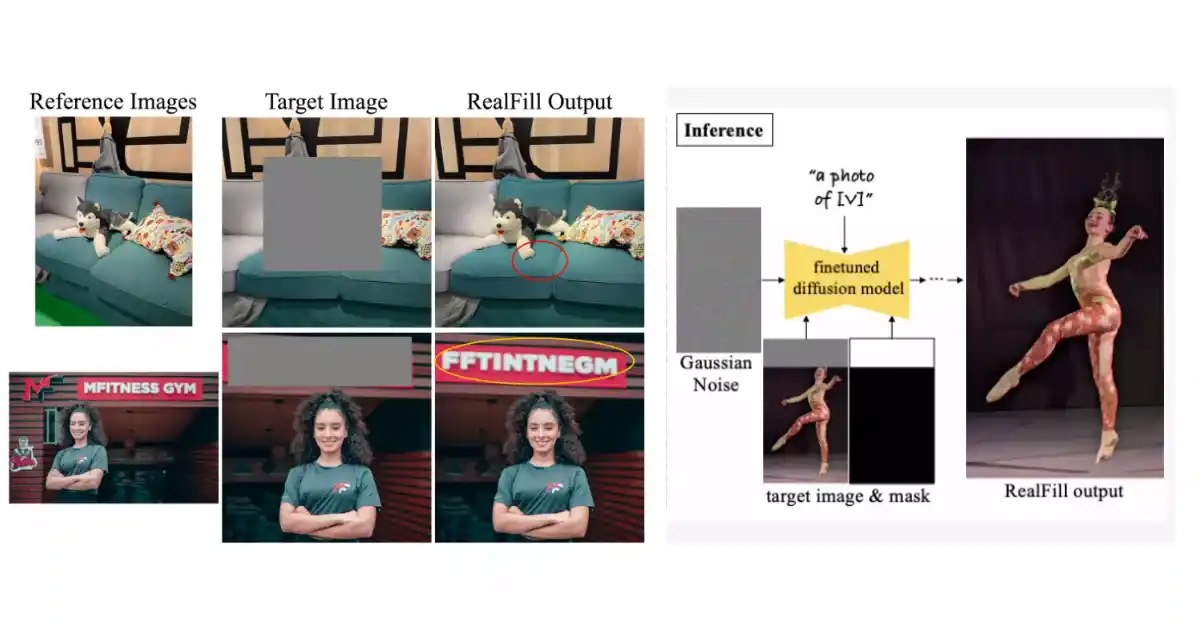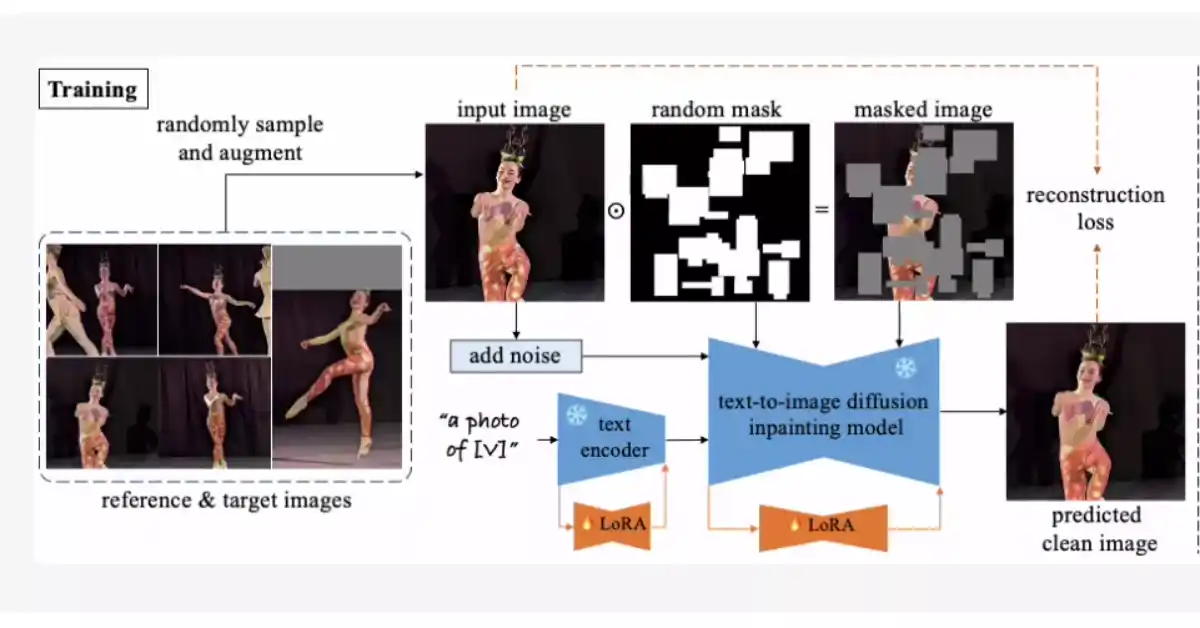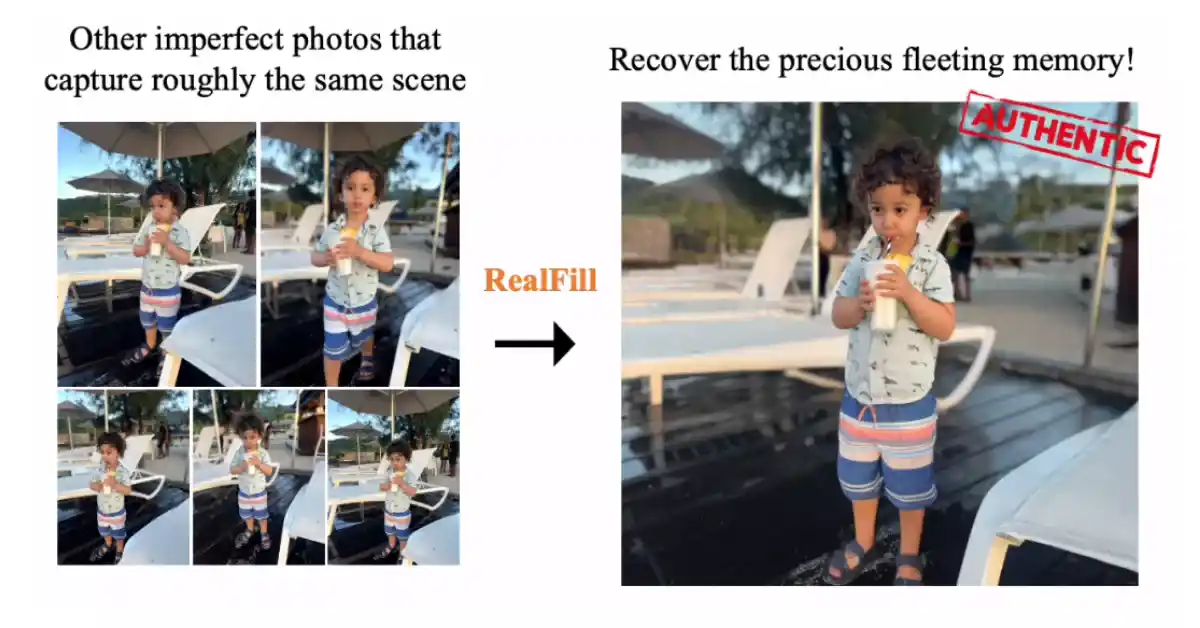Table of Contents
Google RealFill is an AI-powered image completion model that is still under development. Here’s the latest update on it:
- Trademark filings by Google LLC suggest that RealFill might be transitioning from a research project to a commercial product.
- This is further supported by a research paper and a website detailing RealFill’s capabilities.
RealFill uses computer vision to analyze reference photos and understand the scene. It can then generate a new image that fills in missing parts while maintaining consistency with the original scene with high accuracy. This could be helpful in situations where you want to remove unwanted objects from a photo or complete a partially captured image.
What is RealFill?
RealFill is a novel generative approach for image completion developed by Google researchers. It tackles a limitation of existing image editing tools: while they can create plausible content in missing regions of an image, it might not be truly reflective of the original scene. RealFill aims to address this by using a reference-driven approach to complete images with content that aligns with the actual scene.

Here’s a breakdown of how RealFill works:
- Generative Inpainting: Google Realfill falls under the category of generative inpainting models. These models are trained on a massive dataset of images and learn to “fill in the blanks” in incomplete images.
- Reference-Driven Personalization: Unlike traditional inpainting models, Google Realfill leverages the power of reference images. You provide RealFill with several images of the scene you want to complete. These reference images can be from various viewpoints, lighting conditions, or even artistic styles.
- Contextual Understanding: Google Realfill doesn’t simply copy pixels from the reference images. It utilizes computer vision to analyze the reference photos, grasp the context of the scene (including object dimensions, colors, shapes, and their spatial relationships), and then generate a new image that seamlessly fills in the missing parts.
- Unparalleled Accuracy: Google Realfill is claimed to outperform existing models in terms of accuracy. The generated content is said to be not only visually appealing but also highly faithful to the original scene.
Here are some potential applications of RealFill:
- Removing unwanted objects: Imagine you have a perfect photo except for a photobomber in the background. Google Realfill could potentially remove the unwanted element and reconstruct the background based on reference images of the clean scene.
- Completing partially captured images: If you accidentally cut off part of your subject in a photo, Google Realfill could potentially fill in the missing part using reference images showcasing the complete subject.
- Creative image manipulation: Artists and designers could leverage Google Realfill to create unique and realistic compositions by providing them with reference images that inspire a specific mood or style.
Google Realfill promises significant advancements in image editing by enabling content-aware completion that goes beyond simple image interpolation or hallucination.
Is Google Using RealFill?
There’s a good chance Google is planning to utilize RealFill beyond just research. Here’s why:
- Trademark Filings: Google LLC has filed trademarks for RealFill’s logo, suggesting a potential transition from a research project to a commercial product. This signifies Google’s intent to bring RealFill to the public domain.
- Research Paper and Website: The existence of a dedicated research paper and website for RealFill (although not an official Google product page) indicates a serious effort by Google to introduce this technology.

While there’s no official confirmation yet on how Google plans to integrate RealFill, here are some possibilities:
- Standalone Application: Google might develop a standalone application specifically for RealFill, allowing users to edit and complete images using the technology.
- Integration into Existing Products: RealFill could be incorporated into existing Google products like Google Photos, offering a powerful in-built image editing tool.
- Cloud-Based Service: Google might offer RealFill as a cloud-based service, accessible through a web interface or APIs, allowing developers to integrate RealFill functionalities into their applications.
Due to the limited information available publicly, it’s difficult to definitively say how Google will use RealFill. However, the evidence suggests a strong possibility of its commercialization.
How Much Does Google RealFill Cost?
Since Google RealFill isn’t officially available yet, there’s no confirmed pricing information. However, based on potential implementation strategies, we can explore some possibilities:
- Freemium Model: Google might offer a basic version of RealFill for free, with limitations on features or processing power. Upgraded versions with more functionalities or faster processing could be offered as paid subscriptions. This approach is commonly used for cloud-based services and photo editing software.
- In-App Purchases: If RealFill is integrated into existing Google products like Google Photos, it could be offered as an in-app purchase. Users would pay a one-time fee to unlock the Google Realfill functionality within the app.
- API Pricing: If Google provides RealFill as a cloud-based service with an API, developers integrating it into their applications might be charged based on usage. This could involve a pay-as-you-go model where developers are charged based on the number of images processed or a tiered subscription plan with different usage limits.
Here’s a breakdown of the pros and cons of each potential pricing model:
- Freemium Model:
- Pros: Wider user base due to free access, the potential to attract paying customers for premium features.
- Cons: Limited functionality in the free version might frustrate users, and managing different tiers can be complex.
- In-App Purchases:
- Pros: Monetization without a subscription model, potentially lower barrier to entry for casual users.
- Cons: May not be suitable for frequent users who need extensive editing capabilities.
- API Pricing:
- Pros: Flexible for developers based on their application’s needs, potential for wider adoption across various platforms.
- Cons: Can be complex for developers to manage costs, and might limit accessibility for smaller developers.
Ultimately, the pricing model Google chooses will depend on its overall strategy for RealFill. They might prioritize user adoption with a freemium model, focus on professional use with a pay-per-use API, or strike a balance with a combination of approaches.
Is RealFill the Next Big AI-powered Image Model of Google?
RealFill has the potential to be a significant advancement in AI-powered image editing for several reasons:
- Focus on Authenticity: Unlike existing models that may generate unrealistic content, Google Realfill prioritizes staying true to the original scene by utilizing reference images. This could be a game-changer for photo editing tasks that require maintaining visual accuracy.
- Versatility: RealFill’s ability to handle reference images from various viewpoints and lighting conditions makes it highly adaptable. This allows for a wider range of image completion scenarios compared to models limited by specific image requirements.
- Potential Applications: RealFill’s applications extend beyond basic photo editing. It could be used for creative image manipulation, content creation, and even restoration of damaged photos. This versatility could attract a diverse user base, including photographers, artists, graphic designers, and casual users.

However, there are also some factors to consider:
- Stage of Development: RealFill is still under development, and its full capabilities haven’t been publicly demonstrated. Further testing and refinement might be needed before it can compete with established image editing tools.
- Technical Challenges: Training and maintaining complex AI models require significant resources. Google will need to address potential limitations in processing power and ensure efficient model performance for widespread adoption.
- Competition: The AI image editing landscape is constantly evolving. Existing tools and emerging technologies might pose competition to RealFill, requiring Google to continuously improve its technology and user experience.
Conclusion:
Google RealFill emerges as a promising advancement in AI-powered image editing. It tackles the challenge of generating content faithful to the original scene by leveraging reference images. This stands in contrast to existing models that might prioritize creating visually appealing content even if it deviates from reality.
RealFill boasts versatility by handling reference images captured from various viewpoints and lighting conditions. This broadens its applicability for photo editing tasks beyond simple fixes. From removing unwanted objects and completing partially captured images to creative manipulations, RealFill has the potential to empower photographers, artists, graphic designers, and casual users alike.